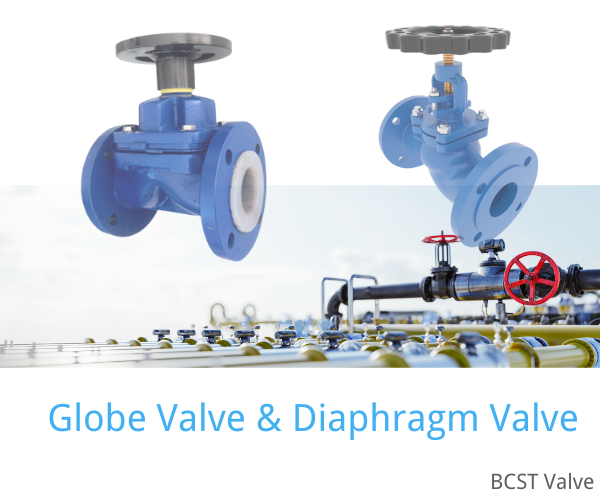
Regarding valves, there are two types: diaphragm and globe. Each has its advantages and disadvantages, but for chemical-resistant valves, one kind of valve may be better than the other.
Diaphragms are the more common option for use with aggressive media like chlorine and other strong chemicals. They’ve also been used in hydraulic fracturing and oil and gas industries because they can withstand high pressures.
Globes also have some advantages over diaphragms—they’re lighter, which means they can be installed without requiring additional equipment or large spaces, and they don’t need as much maintenance. Globes are also easier to repair if they break down during an application (which they will).
Overall, both diaphragms and globes have their strengths and weaknesses; we look at each type of valve and guide you on which would be the best fit for your specific application.
GLOBE VALVES
Globe valves are linear motion valves consisting of a movable plug and a stationary seat in a spherical body. When the valve handle has turned, the plug (or disc) is lowered or raised utilizing the valve stem. When the disc is fully lowered, the fluid flow is shut off; when the disc is fully raised, it is at its maximum rate. With globe valves, variable flow rates proportional to the size of the opening are also possible. Manual globe valves tend to have a threaded stem with a handwheel to open and close using a screw motion. In contrast, automated globe valves usually have smooth stems and are operated via an actuator. The sealing surface is resilient, meaning it withstands wear very well and provides good sealing properties and long service life. This means globe valves are a good solution for frequently operated applications and requirements over long periods, such as in industrial settings where pressure fluctuations are common.
BENEFITS OF GLOBE VALVES
- Simple design means they are easy to maintain and economical to manufacture.
- They are quick to open and close, with relatively low valve height and a short stroke.
- Ideal for smaller spaces.
- Suitable for connections requiring flanges.
- Good stopping results.
- Resilient, with long service life.
- Available in various designs, each with a unique application in mind.
LIMITATIONS OF GLOBE VALVES
- They can be challenging to open and close, and large valves require considerable power.
- Heavier than other valves with similar pressure values.
DIAPHRAGM VALVES
A diaphragm valve consists of a valve body (which has two or more ports), an elastomeric diaphragm, and a weir or seat on which the diaphragm presses to close the valve. The elastomeric diaphragm is a versatile and dynamic seal, often made of a rubber or plastic molded solution with an insert in either a metal or an engineering plastic. A seal is formed when the rubber diaphragm comes into contact with the seat at the top of the valve. The seat of the valve comes in two options: a straight-through design or a saddle design. The saddle design of the diaphragm valve has a spillway effect. It is more commonly used for chemical-resistant valves because a bonnet over the diaphragm and control mechanism keeps liquid contained, preventing leakage, and the saddle shape means that it is self-draining. Solenoid diaphragm valves are another option; they provide automated control of opening and closing via solenoid valves which pull open or close according to pressure from within its container (such as oil).
BENEFITS OF DIAPHRAGM VALVES
- A simple, cost-effective solution. ü
- The fluid only comes into contact with the diaphragm, thus protecting the valve from contamination. ü
- The seal is tight due to the hermetic seal and the elastic nature of the diaphragm material.
- Suitable as a chemical-resistant valve as it adapts well to corrosive fluids.
LIMITATIONS OF DIAPHRAGM VALVES
- Not ideal for larger diameter pipes.
- Poor pressure resistance.
- Only suitable for moderate temperatures.
APPLICATIONS FOR GLOBE VALVES AND DIAPHRAGM VALVES
Globe valve technology is an excellent choice for applications with significant concerns: fast action, leak tightness, maintenance, and safety. Globe valves lend themselves in applications where fast action is needed, where there is a need to keep the system leak-tight, and where it is crucial to have a maintenance-free operation. They can be used in water treatment, chemical production, oil and gas transport, and almost any application where pressure drop is not an issue.
Diaphragm solenoid valves are ideal for corrosive applications, where body and diaphragm materials can be chosen for chemical compatibility. Diaphragm valves are also suitable for abrasive applications, where the body coating can be designed to resist abrasion, and the diaphragm can be easily replaced when worn.
BCST offers a wide range of globe and diaphragm valves suitable for pharmaceutical industries, where they can handle corrosive media and cleaning fluids. If you would like further advice, visit our website, www.bcstvalve.com, for additional information about our many options. These may be globe valves, diaphragm valves, or other solutions that may be suitable for you.






